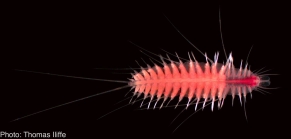WoRMS taxon details
Pelagomacellicephala iliffei Pettibone, 1985
330452 (urn:lsid:marinespecies.org:taxname:330452)
accepted
Species
marine, brackish, fresh, terrestrial
recent only
Pettibone, Marian H. (1985). Polychaete worms from a cave in the Bahamas and from experimental wood panels in deep water of the North Atlantic (Polynoidae, Macellicephalinae, Harmothoinae). <em>Proceedings of the Biological Society of Washington.</em> 98(1): 127-149., available online at http://biodiversitylibrary.org/page/34648400
page(s): 131-133, figure 1 [details] Available for editors [request]
[request]
page(s): 131-133, figure 1 [details] Available for editors
Holotype USNM 96262, geounit Caicos Islands
, Note Conch Bar Cave, Middle Caicos Island, Turks...
Holotype USNM 96262, geounit Caicos Islands [details]
From editor or global species database
Type locality Conch Bar Cave, Middle Caicos Island, Turks and Caicos Islands. Gazeteer geolocation 21.826111, -71.791111. "The cave is developed in a coastal dune-derived hill (Conch Bar Hill) located 500 m inland from the open ocean. It consists of multiple levels, the lowest of which is permanently flooded with tidal brackish waters 10 or more meters deep. The four polynoids were collected from a broad shallow pool containing considerable amounts of organic detritus including leaves, twigs, and land snail shells in the sediments. Surface salinity in the pool was 23 0/00." [details]
Distribution Known only from anchialine habitat of Conch Bar Cave, Middle Caicos, Turks and Caicos Islands, Bahamas.
Etymology author: "named for Thomas M. Iliffe, one of the collectors, in recognition of his interesting studies on cave faunas
Distribution Known only from anchialine habitat of Conch Bar Cave, Middle Caicos, Turks and Caicos Islands, Bahamas. [details]
Etymology author: "named for Thomas M. Iliffe, one of the collectors, in recognition of his interesting studies on cave faunas
Etymology author: "named for Thomas M. Iliffe, one of the collectors, in recognition of his interesting studies on cave faunas [details]
Read, G.; Fauchald, K. (Ed.) (2025). World Polychaeta Database. Pelagomacellicephala iliffei Pettibone, 1985. Accessed through: World Register of Marine Species at: https://www.marinespecies.org/aphia.php?p=taxdetails&id=330452 on 2025-04-17
Date
action
by
![]() The webpage text is licensed under a Creative Commons
Attribution 4.0 License
The webpage text is licensed under a Creative Commons
Attribution 4.0 License
Nomenclature
original description
Pettibone, Marian H. (1985). Polychaete worms from a cave in the Bahamas and from experimental wood panels in deep water of the North Atlantic (Polynoidae, Macellicephalinae, Harmothoinae). <em>Proceedings of the Biological Society of Washington.</em> 98(1): 127-149., available online at http://biodiversitylibrary.org/page/34648400
page(s): 131-133, figure 1 [details] Available for editors [request]
[request]
page(s): 131-133, figure 1 [details] Available for editors
Ecology
ecology source
Gonzalez, Brett C.; Martínez, Alejandro; Borda, Elizabeth; Iliffe, Thomas M.; Fontaneto, Deigo; Worsaae, Katrine. (2017). Genetic spatial structure of an anchialine cave annelid indicates connectivity within - but not between - islands of the Great Bahama Bank. <em>Molecular Phylogenetics and Evolution.</em> 109: 259–270., available online at http://www.sciencedirect.com/science/article/pii/S1055790317300088
note: no evidence of inter-island dispersal [details]
note: no evidence of inter-island dispersal [details]
 Present
Present  Present in aphia/obis/gbif/idigbio
Present in aphia/obis/gbif/idigbio  Inaccurate
Inaccurate  Introduced: alien
Introduced: alien  Containing type locality
Containing type locality
Holotype USNM 96262, geounit Caicos Islands [details]
From editor or global species database
Distribution Known only from anchialine habitat of Conch Bar Cave, Middle Caicos, Turks and Caicos Islands, Bahamas. [details]Etymology author: "named for Thomas M. Iliffe, one of the collectors, in recognition of his interesting studies on cave faunas [details]
Type locality Conch Bar Cave, Middle Caicos Island, Turks and Caicos Islands. Gazeteer geolocation 21.826111, -71.791111. "The cave is developed in a coastal dune-derived hill (Conch Bar Hill) located 500 m inland from the open ocean. It consists of multiple levels, the lowest of which is permanently flooded with tidal brackish waters 10 or more meters deep. The four polynoids were collected from a broad shallow pool containing considerable amounts of organic detritus including leaves, twigs, and land snail shells in the sediments. Surface salinity in the pool was 23 0/00." [details]
To Barcode of Life (15 barcodes)
To Biodiversity Heritage Library (2 publications)
To European Nucleotide Archive, ENA (Pelagomacellicephala iliffei)
To GenBank (44 nucleotides; 29 proteins)
To USNM Invertebrate Zoology Annelida Collection (4 records)
To USNM Invertebrate Zoology Annelida Collection (Holotype USNM 96262)
To Biodiversity Heritage Library (2 publications)
To European Nucleotide Archive, ENA (Pelagomacellicephala iliffei)
To GenBank (44 nucleotides; 29 proteins)
To USNM Invertebrate Zoology Annelida Collection (4 records)
To USNM Invertebrate Zoology Annelida Collection (Holotype USNM 96262)

